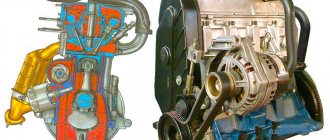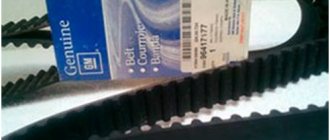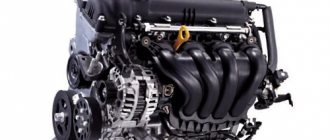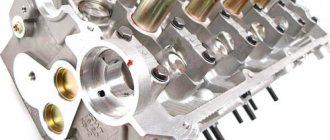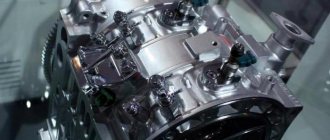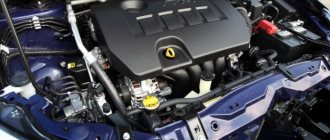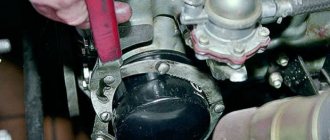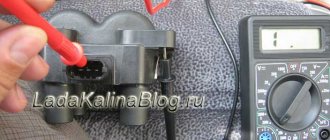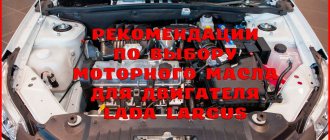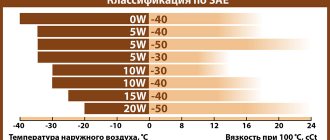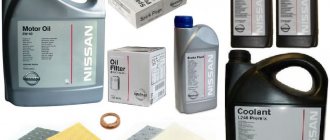Technical specifications HR16DE 1.6 l/110 l. With.
Initially, the engine was based on an in-line design with overhead camshafts according to the DOHC V16 scheme. The engine layout has been improved with a fluid coupling for variable valve timing, an electronic throttle valve and duplicated injectors on each cylinder.
Instead of a timing belt, the manufacturer's designers used a high-life chain drive.
Initially, the volumes of the combustion chambers were increased to 1.6 liters, and high-life attachments were installed. An important feature of the new power unit is increased efficiency, gasoline savings, high performance and reduced energy losses.
The full technical specifications of the HR16DE are as follows:
| Manufacturer | Atsuta Plant, Nissan Motor Manufacturing UK, Oppama Plant, Nissan Motor Iberica SA, Shonan Plant, AvtoVAZ, Aguascalientes Planta, Dongfeng Motor Company |
| Engine brand | HR16DE |
| Years of production | 2006 – … |
| Volume | 1598 cm3 (1.6 l) |
| Power | 81 kW (110 hp) |
| Torque moment | 153 Nm (at 4400 rpm) |
| Weight | 120 kg |
| Compression ratio | 9,5 |
| Nutrition | injector |
| Motor type | in-line petrol |
| Ignition | COP system, 4 coils on spark plugs |
| Number of cylinders | 4 |
| Location of the first cylinder | TVE |
| Number of valves on each cylinder | 4 |
| Cylinder head material | aluminum alloy |
| Intake manifold | plastic |
| An exhaust manifold | steel welded |
| Camshafts | 8 cams, DOHC design |
| Cylinder block material | Aluminium alloy |
| Cylinder diameter | 78 mm |
| Pistons | aluminum, short skirt |
| Crankshaft | cast iron |
| Piston stroke | 83.6 mm |
| Fuel | AI-95 |
| Environmental standards | Euro 4/5 |
| Fuel consumption | highway – 5.5 l/100 km |
combined cycle 6.4 l/100 km
city – 8.9 l/100 km
real 350000 km
flywheel - 107.8 Nm
clutch bolt – 57 Nm
bearing cap - 32.4 Nm + 60° (main) and 27.5 Nm, flap, 19.6 Nm + 60° (rod)
cylinder head – 66 Nm, weakening, 40 Nm + 75° + 75°
When making major repairs in a garage with your own hands, the manufacturer recommends using an official manual with detailed instructions for servicing components.
Reviews from Nissan Tiida owners
The Tiida model is quite popular among domestic car enthusiasts. In order to understand in more detail how the car behaves in real operation, you can read the reviews of the owners.
Power unit 1.6
- Oleg. Nissan Tiida 1.6 l., 2007, 205,000 km. After overcoming more than two hundred thousand, I can summarize that this is a very high-quality car. I think that I earned my money absolutely honestly. There are some shortcomings, but they do not critically affect the overall operating experience. One of the keys to long and trouble-free operation of the engine is consumables. I only use high quality oil. I refused the original because it coked a lot. Interval 10 thousand. Changed spark plugs every 50 thousand. During the entire period of operation there was no unscheduled work on the engine. All repairs concerned only the chassis. Of the most annoying troubles, I would like to mention belt whistling. But this is a very well-known problem on many Nissans. Otherwise, the car pleases with comfort and trouble-free operation.
- Yuri. Nissan Tiida 1.6 l. 2006 onwards, 235,000 km. At first I didn't like her at all. Even scared me off with its strange design. However, then, out of curiosity, I decided to try to sit down and evaluate it. Then there was a test drive and price comparison with competitors. As a result, the rational approach won and I became the owner of this car. And I will say that after more than ten years of operation I have not regretted it at all. During all this time the car never presented any unpleasant surprises. It always started and went where I wanted. I'm very glad that this engine has a chain. There is no need to constantly think about changing the belt soon. This is important for me because the mileage is relatively large. There were no questions about the engine at all. All work that was performed was only planned. Plus all sorts of related minor work. I cleaned the throttle a couple of times, flushed the fuel system for preventive maintenance, and welded the muffler. The remaining repairs were related only to the replacement of suspension parts. I try to pour high-quality oil and don’t delay the replacement too much. Mostly I change it at 7-8 thousand. After all the years of operation, I am very pleased with this motor. It is enough both in the city and on the highway. Of course, this is not a sports car, but regular overtaking allows you to perform confidently.
Motor 1.8
- Alexander. Nissan Tiida 1.8 l., 2008, 165,000 km. I bought a car with 60 thousand mileage. I drove a little over a hundred myself. At first I didn’t even look in its direction, but then, on the recommendation of a friend, I began to take a closer look at this model. The design is certainly not for everyone, but I really liked everything else. Spacious interior, decent trunk, and most importantly, reasonable price. I wanted the 1.8 engine, because I like it to have power reserves. Impressions from the engine were only positive. On the track I felt very confident. And there were no unpleasant surprises in service. I guess I was lucky, but I practically didn’t eat any oil, although they say that these engines have such an unpleasant feature. I had to change the clutch at 100 thousand, I set it on fire due to carelessness. Only light repairs were performed on the engine. Cleaned the throttle body and washed the injectors. During the time I had the car, I changed two attachment belts. All other work was related only to the replacement of consumables and suspension. Overall, I was happy with the car, and there was no reason to sell it. There was a need for a larger car. I also switched to the Nissan X-Trail and somehow began to trust this brand.
- Dmitriy. Nissan Tiida 1.8 l., 2006, 210,000 km. I chose Tiida after sitting in the salon. None of our classmates offered such space. And the price was very pleasing. So I became the owner of a new Nissan. I had a little doubt about which engine to choose, but it was still decided to go with a more powerful option. From an operational point of view, I was very pleased. Good dynamics and pickup even at high speeds. On the highway I accelerated to 180. But mostly 120-140. For a long time I did nothing at all on the engine. I just changed the oil, filters and other consumables. At 140 thousand the engine began to work strangely. And normal cravings disappeared. At the service station they gave a verdict - the chain had stretched. I had to replace it. The oil has been losing a little since 50 thousand. But just a little. Within a liter per 10 thousand. But after 150 thousand it began to gradually increase. By the time of sale, 210 thousand already had approximately 0.5 liters per 1 thousand km. As I understand it, the problem is in the underlying rings. This is a feature of these engines. Otherwise the car did not cause any problems. A simple and reliable workhorse for every day. There are no frills in it, but it performs its functions quite well.
Design Features
The HR16DE engine developed by the Renault-Nissan Alliance received the following design features:
- cylinder block - to improve the dynamics of the car, it is made of light alloy, “wet” liners are installed inside;
- injection system - two nozzles per cylinder;
- gas distribution scheme - intake and exhaust camshafts are placed inside the cylinder head, each of them controls 2 valves according to the DOHC scheme;
- cylinder head – height 125 mm, misalignment 0.1 mm maximum;
- phase adjustment - engine modernization consists of using a fluid coupling on the input camshaft, the oil pressure is controlled by an electromagnetic valve;
- Throttle valve – controlled electronically from the ECU.
Since different Nissan models do not use the same ECU firmware versions, it is necessary to study the description of the parameters before using the power drive. But independent boosting and overhauls are possible as needed.
During the release of the HR16DE engine, Nissan management did not use naturally aspirated or turbocharged modifications, since the basic version completely satisfied the developers. If it is necessary to increase power or reduce this characteristic for a specific market, the factory settings are changed, which the user can restore independently by flashing the version of the on-board computer software.
Engine malfunctions and repairs Qashqai / Tiida / Beetle / Note HR16DE
The Renault-Nissan H4M-HR16DE engine is an evolution of the Renault K4M; it replaced the QG16DE in the Nissan line. The engine is not bad, it is not demanding on gasoline, with the recommended 95, you can use 92. The timing system uses a chain, here it is quite reliable and its early stretching will not bother you. There is a variable valve timing system, a phase shifter is installed on the intake shaft, an electronic throttle valve is used, but the valve clearances on the HR16DE need to be adjusted; there are no hydraulic compensators. The gaps are adjusted by selecting a pusher, approximately every 80-100 thousand km. Engine noise and knocking are the main signs of an imminent trip for adjustment. This engine has been modernized, the camshafts have been changed, two injectors are now installed on each cylinder, fuel economy has increased, power has increased slightly, idle speed has decreased, the engine has begun to comply with Euro 5 requirements and other, less significant, transformations. Let's talk about malfunctions and ways to repair them on the HR16DE-Н4М. 1. Engine whistle. As with many Nissan engines, this whistle is nothing more than the sound of the alternator belt; the problem is solved by tightening it, but if there is nowhere to pull, then replacing the belt. 2. The engine stalls. Here the problem is in the ignition unit relay; Nissan recalled a batch of cars for this fault. With this malfunction, you risk stalling in the middle of the road and it is not a fact that you will start. The problem is solved by ordering a new ignition unit relay. 3. Burnout of the exhaust pipe ring. Symptoms: at medium speeds when accelerating, a more angry sound is heard. Change the gasket and drive further in silence. 4. Engine vibration. Typically, this is a symptom of the impending demise of the right HR16DE-H4M engine mount. Replacement will solve all issues. In addition, the HR16DE-H4M engine does not start well and stalls in severe frost (from -15 C), you can change the spark plugs, start with gas, this will improve the situation a little, but in general, this is such an unpleasant feature of the engine. On the CVT variator, shocks are felt when switching. To summarize, the HR16DE-H4M is a completely ordinary engine in its class, no worse, but no better than its analogues, a kind of smaller version of the MR20DE. Is it worth buying a car with such an engine? If you are a calm person and racing is not for you, of course it’s worth it, otherwise look at more powerful engines.
Advantages and disadvantages
The main advantages of the HR16DE engine for owners of cars in which it is the power unit can be considered the following:
- environmental friendliness is not lower than Euro-4/5;
- economical consumption of working fluids and fuel;
- the possibility of using gasoline with an octane number of 91 (AI-92);
- actual service life of more than 400,000 km;
- high-resource attachments;
- possibility of independent atmospheric and turbo tuning.
Conditional disadvantages are the loud sound of the chain and the need to adjust the thermal valve clearances after 30,000 km. On the other hand, this dramatically simplifies the design, increases maintainability and reduces the operating budget.
Timing chain replacement for Nissan Primera p12 1.8
If, while driving a Nissan Primera P12, the chain makes certain sounds, this means that it has stretched and the tensioner is no longer able to cope with its task. You can contact the service, or you can make the replacement yourself. You will have to spend 4-5 hours of your time on this, but in this case there will be no need to spend money, unless, of course, you count the purchase of the chain itself. We will not disassemble the power unit itself. In order for the chain to be replaced efficiently, you only need to follow the instructions in this instruction. Now let's proceed directly to the procedure for replacing the chain.
List of car models in which it was installed
The HR16DE naturally aspirated in-line engine was developed by the designers of the Renault-Nissan alliance for the following Nissan models:
- Juke – mini-crossover;
- Sentra – export version of the Sunny sedan;
- Qashqai – urban crossover;
- Tiida – sedan and hatchback;
- Note – subcompact van;
- NV200 – LCV-class van and minivan;
- Versa – hatchback and sedan for North America;
- Grand Livina – compact MPV for Malaysia;
- Latio – B-class sedan for Malaysia;
- Bluebird Sylphy – front-wheel drive and all-wheel drive C-class sedan for China and Thailand;
- Cube – subcompact van for Europe;
- Wingroad – utility vehicle;
- Micra is a hatchback made in England.
Maintenance schedule HR16DE 1.6 l/110 l. With.
Taking into account the engine characteristics and operating conditions of the Russian Federation, the manufacturer has developed the following maintenance schedule:
- The service life of the timing chain is from 150,000 km, of attachment drive belts - from 50,000 km;
- the fluid in the cooling system must be replaced after 50,000 km;
- the filter and engine oil should be changed after 10,000 miles;
- the crankcase ventilation should be cleaned after 20,000 km;
- The life of the air filter is limited to 1 year or 20,000 mileage, the fuel filter is 30,000 km;
- spark plugs are designed for 20 - 30 thousand mileage, batteries for about 5 years.
Depending on the conditions under which the HR16DE engine is operated, the exhaust manifold begins to burn out after 40 - 70 thousand mileage.
Tools and spare parts
Timely replacement of the timing chain will save you from additional financial costs in the event of a break while the engine is running. Then, most likely, you will have to change the entire engine. First, inspect the tensioner. The second stage of the test is to disassemble the QG18DE engine, visually inspect the chain links and components: guide bars, sprockets on the shafts.
For replacement, prepare original parts:
- Timing chain QG18DE - 13028-4M51A
- guide bar - 13085-7J600
- damper - 13091-7J600
- O-rings for pump and oil pump - 15066-5E510
- valve cover gasket -13270-95FOB
- crankshaft oil seal - 13510-95FOA
- hydraulic tensioner - 13070-95FOA
Tools and accessories you will need:
- pulley and sprocket puller
- set of keys, sockets, screwdrivers
- jack
- punch
- hammer
- cleaning material
- penetrating lubricant
- Reinzosil sealant,
- silicone solvent
- pliers
- adjustable and torque wrenches.
Engine tuning options
If you make any changes to the HR16DE engine mechanically, you will need to reinstall the on-board computer software version. Regular chip tuning can add about 5% power, but by itself does not solve problems.
Atmospheric tuning includes the following operations:
- reducing back pressure inside the exhaust tract - direct-flow exhaust with a cross-section of 61 mm, a spider instead of an exhaust manifold, dismantling oxygen sensors, installing one or two resonators in series;
- increasing the intake air volumes - a separate throttle for each cylinder or a zero-resistance filter with grinding of the intake manifold channels;
- modification of the cylinder head and timing belt - grinding the head, installing wide-phase camshafts.
Supercharged tuning can increase power to 160 hp. pp., but the pressure should be limited to 0.5 bar. When installing a turbine, high-performance injectors, modifications to the exhaust tract, and pistons with recesses will be required to reduce the compression ratio.
Thus, the HR16DE engine developed by the Renault-Nissan Alliance has the additional marking H4M, the combustion chamber volume is 1.6 liters and the power is 110 hp. With. The engine is considered a reliable, economical and lubrication/fuel-friendly power drive for SUVs.
Home page » Selecting oil by car brand » Oil for Nissan engines of different models
Nissan engine malfunctions:
At the moment it’s difficult to say anything about this engine in the VAZ version, because sales began relatively recently and the mileage of these engines is minimal. But the long history of the life of these engines on other cars can tell us something:
- Alternator belt whistling (tighten or replace belt)
- engine knocking during operation (most likely it’s time to adjust the valve clearance)
- hard to start in cold weather
The range of other motors installed on Vesta:
- VAZ 21179 1.8 l, 122 hp
- VAZ 21129 1.6l 106 hp
It is still unknown which transmission this engine will be paired with. In principle, both new mechanics and our robot will do.
Oil for Nissan engines of different models
Many car enthusiasts are wondering about choosing the most effective lubricants for Nissan cars. To make an informed choice, it is necessary to study the main characteristics of the vehicle and the conditions of use: type of power unit, mileage, climate.
As additional information, you can familiarize yourself with the tolerance specified for a particular car model. Such information is written in the service manual or can be found on the Internet. The most significant are ACEA and SAE approvals. As for the second, it indicates the viscosity class.
Selection by viscosity grade
Every experienced motorist is familiar with indicators such as 5w30, 10w40 and so on. These numbers indicate the temperature index of use of the motor fluid. The most popular markings in the domestic space are: SAE 0w-20°/+35°C.
For countries with cold climates, oils with SAE 5w30 ratings with temperatures from -30° to +35° are most often used. In temperate zones, it is best to fill with SAE 5w fluid at the same temperature. No less relevant is a lubricant with the characteristics of 5w40.
ACEA approval should not be ignored either. This indicator demonstrates compatibility with internal combustion engines. Passenger cars Nissan Qashqai, Primera, Almera, X-Trail, Tiida, Teana, Postfinder, Murano with left-hand drive work perfectly on lubricant with A3/B4 ratings.
These are standard types from the manufacturer Nissan, marked 5w40. If it is not possible to use original products, experienced specialists recommend using oils from the company:
First of all, you should pay attention to tolerances, the company’s reputation and the final cost. However, if we talk about the price aspect, then for Nissan 5w40 oil you will have to pay around 2000-2300 rubles for a 5 liter canister. This is significantly cheaper than foreign analogues.
Replacement frequency
The manufacturer recommends changing the oil on the Almera G15 every 15 thousand kilometers. If the car is not used very often, then replacement is carried out once a year. Less commonly, it can be harmful to the engine, because the oil ages and loses its properties with age.
The replacement interval can be adjusted downward, but never upward. It is necessary to change engine lubricant more often under intense loads on the internal combustion engine, regular overheating, the use of low-quality fuel and oil, when the engine is severely clogged, and under other unfavorable conditions.
How much oil is in the engine lubrication system, volume table for Nissan Almera G15:
| Engine capacity | Motor marking | How many liters of oil are in the system | Original oil / factory filled |
| gasoline 1.6 | K4M | 4.8 | Nissan Motor Oil 5W-40 / Nissan SN Strong Save X 5W-30 |
Selection of oil for Nissan models
Oil for Nissan Primera with gasoline engines GA16DS, SR20DI, SR20DE
For all types of power units with the specified parameters, the use of the following lubricants is recommended:
- branded lubricants from the vehicle manufacturer;
- liquids type SG, SF according to API classification;
- The viscosity class is selected according to climatic conditions and engine parameters.
If we are talking about the approximate volume of the product used, then for replacement you will need:
- SR20DI – 3.2 and 3.4 liters, respectively;
- GA16DS – 2.8 and 3.2 liters.
The choice of viscosity class is made according to temperature conditions:
- range from -25°C -10°C – 5w20;
- from -25°C+15°C – 5w30;
- from -20°C+40°C – 10w30.
It is best to use products with a viscosity grade of 10w30 in areas where temperatures exceed 20°C. For hot climates, oils with a viscosity of 20w50, 20w40 are used.
Qashqai
As for the use of lubricants for the Nissan Qashqai engine, special attention should be paid to the manufacturer’s recommendations. Therefore, it is best to fill car power units with synthetic-based substances with a viscosity class of 5w40.
Since the Qashqai 2.0 internal combustion engine system holds 4.5 liters, it is necessary to purchase 5-liter cans with original oil.
Nissan X-Trail
According to the performance characteristics of gasoline engines QR20DE, QR25DE, original fluids from Nissan should be used for them:
- according to the API system with classes SH, SG, in some cases SJ are used;
- according to the ACEA 98B1 system;
- according to ILSAC classification type GF1.
For temperatures from -30°C, 10w30 lubricants are used. For areas with hot climates, it is necessary to use products with a viscosity of 20w40.
A dry Nissan X-Trail engine will require about 4.5 liters of oil. With the base liquid it will take about 3.5 liters.
Nissan Beetle
HR16DE power units running on gasoline need to be filled with lubricant with the characteristics and requirements:
- original products from the car manufacturer or a foreign analogue;
- high quality according to the SL, SM - API system;
- ACEA compliance;
- quality standards ILSAC GF4, GF3;
- viscosity class according to climatic conditions.
For diesel-powered Nissan Juke power units, the following fluid is used:
- from a car manufacturer;
- ACEA system class – C4;
- according to the SAE classification, the oil viscosity should be 5w30;
- low-ash mixtures "Low SAPS".
Any replacement of a lubricant with diesel fuel will not do without 4.4 liters, and taking into account the oil filter 4.24 liters.
Nissan Teana
According to the performance characteristics of the car, the manufacturer recommends using branded oil. The manual instructions describe the parameters: viscosity, class, type and features of use.
After a thorough study of the parameters, you can begin choosing a motor lubricant, taking into account:
1). Season when the liquid can be applied. Experts do not recommend pouring separate products for summer or winter. It is better to use off-season oils, since they can be used both in winter and summer. However, any type of mixture used has its own characteristics, additives and flow rates;
2). The basic basis of the substance taken. It is not recommended to use mineral fluids on Nissan Teana units. Uninterrupted operation is ensured only thanks to synthetic and semi-artificial lubricants;
3). The presence of special markings on the oil canister, demonstrating certain characteristics and properties for a particular type of engine.
Teana L33 2014 release
According to the performance characteristics of the car, experts recommend using QR25DE for units:
- original mixture from Nissan;
- quality standard SM, SN, SL according to API;
- quality level from ILSAC – GF5, GF4, GF3.
As for the filling volume of the lubricant on VQ, QR power units, it is 4.3 liters, and taking into account the filter, 4.6 liters.
Nissan Tiida 2004-2014 release
According to the prescribed instructions for Nissan Tiida models with MR18DE, HR16DE engines, it is necessary to use special types of fluid:
- branded lubricants from Nissan or similar oils from foreign manufacturers;
- ACEA quality – class A1B1, C2C3;
- ILSAC standards – lubricant GF4, GF3;
- API standards – types SM, SL.
The viscosity level is selected according to climatic conditions.
Nissan Almera
Manufacturers recommend using Nissan brand oil with a viscosity level of 5w30 or 5w40. These indicators correspond to synthetic-based products for off-season use. The filling capacity is 4 liters.
You can also use foreign analogues:
- Total Future 5w30;
- Mobil 5w40;
- Petro-Canada 5w30.
Any use of oil for a Nissan car must be considered and tested. You should not purchase lubricant products that do not meet the parameters of the internal combustion engine system, as this can lead to wear and complete deformation of the engine.
| 1) adjusting the thermal clearances of the valves | ||
| Increased oil consumption | 1) scuff marks on the cylinder bore | |
| 1) cylinder honing | ||
| Sharp knocking noise at idle when accelerating | 1) wear of connecting rod bearings | |
| 1) replacement of liners | ||
| Clunking noise when revving at idle | 1) wear of main bearings | |
| 1) replacement of liners | ||
| Whistling | The alternator belt is loose or overtightened | adjusting tension or replacing the belt |
Replacing the timing chain of Nissan Primera
The Nissan Primera in the P10 body debuted for the first time in 1996, then two more generations were released (P11 and P12), the model was discontinued in 2008. All Primera gasoline power units had a timing chain drive; the following engines were installed on the vehicles:
Primera engines of the QR series were also installed on Nissan X-Trail, Serena, Teana cars; this power unit replaced the engines of the SR model. Changing the timing kit on QR engines yourself is quite difficult; it is better to trust such work to specialized car services. In terms of time, replacing a Nissan Primera timing chain with a QR internal combustion engine takes on average from 9 to 12 hours, and without good plumbing skills such a repair can take a long time.
